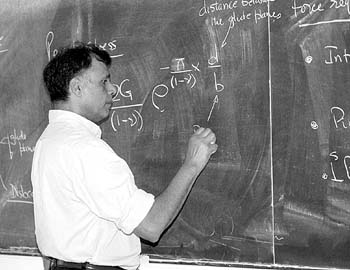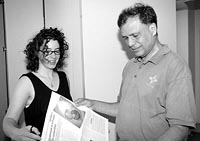| |
| visiting professor |
 Fenomeni e processi a livello atomico Stimolanti prospettive di collaborazione in Ingegneria dei materiali tra le Università del Colorado e di Trento Intervista di Francesca Menna a Rishi Raj  The Indian professor Rishi Raj of the University of Colorado has been a guest at the Faculty of Engineering of Trento during the last semester. Within the course of Materials’ Science and Technology II, he has particularly developed the aspects concerning the processes of deformation and fracture of materials at high temperatures (1000-1500 °C).
Professor Raj, what about your career up to now? I left India in 1961 and went to England to study Electrical Engineering as an undergraduate at Durham University. In 1965 I joined the PhD programme in Applied Sciences at Harvard University; this program is interdisciplinary and small so the students migrate from one area to another. That is why I changed from electrical engineering to material sciences. I got my PhD in 1970 and then, after working for Kennecott Copper Company for one year, I became an assistant professor of Mechanical Engineering at the University of Colorado in Boulder. After four years in this position I moved to the Department of Materials Science at Cornell University. It was at Cornell that much of my research over the last twenty five years was carried out. In 1996 I returned to my old department at the University of Colorado. What is your research area? My principal area of research consists in understanding how to relate the mechanical properties of materials to the atomic structure, how to create models that relate atom movement in solids to phenomena that can be measured in a laboratory. I am interested in this relationship between phenomena and atomic level processes. And what have you taught here in Trento?
What do you think it is better: basic or applied research? Well, you always need a balance but I think for education, in the sense of educating students, basic research is better because when they ask and find the answer to a very basic question they have learned to think more deeply and creatively. They begin to ask new questions and this process lasts their whole lifetime. Basic research prepares our students better even for applied research, since they learn to ask more abstract questions: this can lead to invention of totally new technologies such as genetic engineering, e-mail and the Internet. What are the applications of your research? We are now beginning to use models to develop concepts that can lead to new science and technology. For example, we are beginning to suggest new mechanisms of how mechanical force interacts with chemical energy. These concepts have applications in the biological world: in the immobilization of cells, and in the growth of cells through a mechanical constraint. For example Professor Carturan in Trento is using cells, which are constrained, to serve as artificial organs for the production of insulin. The application of our work would be to explain why cells that are constrained stop reproducing but continue their other biological functions. What do you think about this experience at the University of Trento? It is a wonderful experience. I like people here and I like the relations with colleagues and students, also the human interactions. Which differences have you found between Italian and American students? It is a different culture here. In the U.S., in research, at the graduate level, the students come from all over the world. It is more international. Moreover, in the U.S. we have a larger number of graduate students: at the top universities, for example at Harvard University, nearly half of the student population consists of graduate students. Also, I have the impression that the American Universities can draw upon a greater variety of sources for funds, for both education and research; these include not only the government, but also private donations, foundations, industry and endowment income. Could you cite some of your important works? One is dated 1993. We looked at atoms at a diamond-silicon interface and we discovered that carbon can coordinate in two ways: it can coordinate in the flat molecule or in the tridimensional molecule. It makes the difference between whether you get the diamond structure or whether you get graphite. We wrote an interesting article on bonding in graphite/diamond which appeared on Nature, 366 with the title of "Mapping sp2 and sp3 States of Carbon at a Subnanometer Spatial Resolution" (D. A. Muller, Y. Tzou, R. Raj and J. Silcox, , pp. 725 727, and p. 721 23/30 December 1993). What are your projects for the near future? Well, I will go back to Colorado but we are going to have a continuing interaction with Professor Soraru. I am hoping that one of his PhD students will come to Colorado and work with us. On the other hand, one of my students is coming to Trento for research for three or four months. We are also trying to see whether we can have a formal relationship between the University of Trento and the University of Colorado, so to create an agreement for exchanges first at the graduate level and then extending it to undergraduate students as well. |